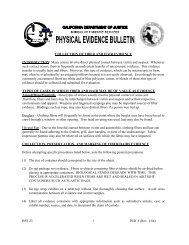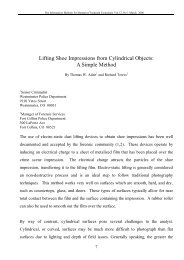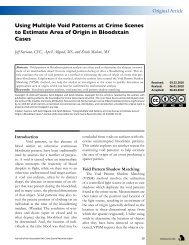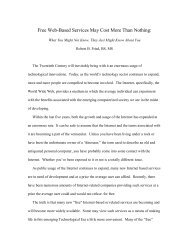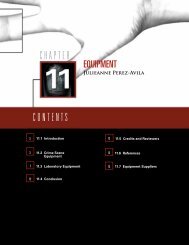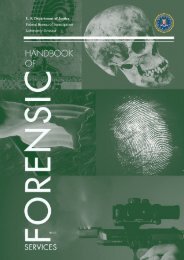PHYSICAL EVIDENCE MANUAL - Crime Scene Investigator Network
PHYSICAL EVIDENCE MANUAL - Crime Scene Investigator Network
PHYSICAL EVIDENCE MANUAL - Crime Scene Investigator Network
Create successful ePaper yourself
Turn your PDF publications into a flip-book with our unique Google optimized e-Paper software.
Physical Evidence Manual<br />
• Clothing<br />
• Personal belongings<br />
Note observable evidence (e.g. weapons, bloodstain patterns, attempts to modify<br />
scene, etc.)<br />
Record and Collect Physical Evidence<br />
• Photograph all items in place before collection, with and without a scale.<br />
• When possible, have one person act as an evidence custodian. This<br />
individual will collect, package, and record all evidence.<br />
• Focus first on the evidence that could be readily lost (e.g., loose fibers and<br />
hairs) and leave the least transient evidence for last. If a body is at the<br />
scene, move it last. Under Oregon law only the Medical Examiner or<br />
District Attorney can approve the removal of the body.<br />
• Ensure collection and packaging is sufficient and appropriate for the<br />
evidence.<br />
• Consider whether the evidence could have been moved inadvertently. Do<br />
not attempt to replace evidence if it was moved. Interview medical<br />
personnel or first responders to assess their movements in the scene and<br />
their possible effect on the position of evidence.<br />
• Consider whether or not the scene and evidence appear intentionally<br />
contrived, staged, or otherwise altered.<br />
• Do not handle evidence excessively. Allowing others to observe or handle<br />
the evidence simply to satisfy curiosity can compromise delicate evidence<br />
such as DNA, latent prints, or trace evidence.<br />
• Evidence containing blood or other biological fluids should be completely<br />
air-dried before it is packaged and submitted to the laboratory.<br />
• Evidence contaminated with wet blood or potentially infectious materials<br />
should be secured and transported in a leak proof container prior to airdrying.<br />
Remember that packaging wet items (e.g. blood soaked clothing)<br />
may destroy useful bloodstain patterns if folded up wet.<br />
• Mark evidence packaging. If you mark the actual item be careful not to<br />
destroy, contaminate, or obscure forensically important detail on the<br />
evidence.<br />
• Obtain the appropriate standards.<br />
• Obtain the appropriate controls.<br />
Conduct Final Survey<br />
• Discuss the search jointly with all team members for completeness.<br />
• Check to ensure all evidence, including film, is accounted for before<br />
departing scene.<br />
• Make sure any possible hiding places or difficult access areas have not<br />
been overlooked during the search.<br />
Adopted: May 2002<br />
Revisions: 6<br />
Last Revision: January 31, 2008<br />
8-7



